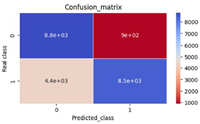Topological analysis of multiple tables
Abstract
The paper proposes a topological approach in order to explore several data tables simultaneously. These data tables of quantitative and/or qualitative variables measured on different homogeneous themes, collected from the same individuals. This approach, called topological analysis of multiple tables (TAMT), is based on the notion of neighborhood graphs in the context of a joint analysis of several data tables. It allows the simultaneous study of possible links between several thematic tables. The structure of the correlations or associations of the variables in each thematic table is analyzed according to the quantitative, qualitative, or mixed variables considered. Like multiple factorial analysis (MFA), the TAMT allows several tables of variables to be analyzed simultaneously, and to obtain results, in particular graphical representations, which make it possible to study the relationship between individuals, variables, and tables of data. These can also be tables of temporal data, collected at different times on the same individuals. The proposed TAMT approach is illustrated using real data associated with several different homogeneous themes. Its results are compared to those from the MFA method.
References
[1]Dazy F, Le Barzic JF, Saporta G, et al. Evolutionary Data Analysis—Methods and Applications (French). Editions TECHNIP; 1996.
[2]Escofier B, Pagès J. Implementation of MFA for Numerical, Qualitative, or Mixed Tables (French). Publication Interne de l’IRISA; 1985. p. 429.
[3]Lavit C. Joint Analysis of Quantitative Tables (French). Editions Masson; 1988.
[4]des Planttes HLH. Structuring Tables with Three Statistical Indices (French). Université des Sciences et Techniques du Languedoc; 1976.
[5]Bouroche JM. Analysis of Ternary Data: Double Principal Component Analysis (French) [PhD thesis]. Université de Paris VI; 1975.
[6]Abdesselam R. A topological clustering of individuals. In: Brito P, Dias JG, Lausen B, et al. Classification and Data Science in the Digital Age. Springer; 2022. pp. 1–8.
[7]Abdesselam R. A Topological Clustering of Variables. Journal of Mathematics and System Science. 2021, 11(2): 1–17. doi: 10.17265/2159-5291/2021.02.001
[8]Aljarah I, Faris H, Mirjalili S, et al. Evolutionary Data Clustering: Algorithms and Applications. Springer Singapore, 2021. doi: 10.1007/978-981-33-4191-3
[9]Panagopoulos D. Topological data analysis and clustering. In: Daras NJ, Pardalos PM, Rassias M (editors). Analysis, Cryptography and Information Science. World Scientific; 2023.
[10]Batagelj V, Bren M. Comparing resemblance measures. Journal of Classification. 1995, 12(1): 73-90. doi: 10.1007/bf01202268
[11]Lesot MJ, Rifqi M, Benhadda H. Similarity measures for binary and numerical data: a survey. International Journal of Knowledge Engineering and Soft Data Paradigms. 2009, 1(1): 63. doi: 10.1504/ijkesdp.2009.021985
[12]Zighed DA, Abdesselam R, Hadgu A. Topological Comparisons of Proximity Measures. Lecture Notes in Computer Science. Published online 2012: 379-391. doi: 10.1007/978-3-642-30217-6_32
[13]Kim JH, Lee S. Tail bound for the minimal spanning tree of a complete graph. Statistics & Probability Letters. 2003, 64(4): 425-430. doi: 10.1016/s0167-7152(03)00208-6
[14]Park JC, Shin H, Choi BK. Elliptic Gabriel graph for finding neighbors in a point set and its application to normal vector estimation. Computer-Aided Design. 2006, 38(6): 619-626. doi: 10.1016/j.cad.2006.02.008
[15]Toussaint GT. The relative neighbourhood graph of a finite planar set. Pattern Recognition. 1980, 12(4): 261-268. doi: 10.1016/0031-3203(80)90066-7
[16]Abdesselam R. Mixed principal component analysis (French). In: Classification: Crossed Points of View (French). Cépaduès; 2008. pp. 31–41.
[17]Caillez F, Pagès JP. Introduction to Data Analysis (French). SMASH; 1976.
[18]Lebart L. Survey data processing strategy (French). La Revue de MODULAD. 1989; 3: 21–29.
[19]Ward JH. Hierarchical Grouping to Optimize an Objective Function. Journal of the American Statistical Association. 1963, 58(301): 236-244. doi: 10.1080/01621459.1963.10500845
[20]Fowlkes EB, Mallows CL. A Method for Comparing Two Hierarchical Clusterings. Journal of the American Statistical Association. 1983, 78(383): 553-569. doi: 10.1080/01621459.1983.10478008
[21]Hubert L, Arabie P. Comparing partitions. Journal of Classification. 1985, 2(1): 193-218. doi: 10.1007/bf01908075
[22]2021 economic reports of French regions (French). Available online: https://www.insee.fr/fr/information/6456000 (accessed on 31 December 2021).
[23]Overview of renewable electricity (French). Available online: https://assets.rte-france.com/prod/public/2022-02/Pano-2021-T4.pdf (accessed on 31 December 2021).
[24]Poverty in the regions (French). Available online: https://www.inegalites.fr/La-pauvrete-dans-les-regions (accessed on 31 December 2021).
[25]France map of carbon footprint by region (French). Available online: https://www.hellocarbo.com/empreinte-carbone-francais-2021-par-region/ (accessed on 31 December 2021).
Copyright (c) 2024 Rafik Abdesselam

This work is licensed under a Creative Commons Attribution 4.0 International License.











